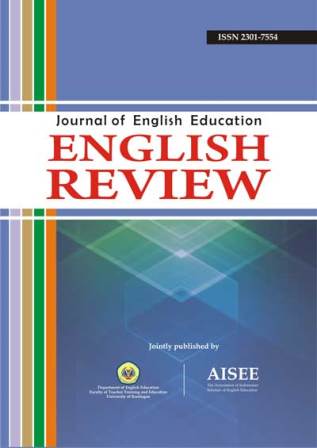ACOUSTIC MEASUREMENT ON VOWEL PRODUCTION OF ENGLISH AS A SECOND LANGUAGE BY INDONESIAN EFL LEARNERS
Abstract
Indonesian is the most widely spoken language in Indonesia. More than 200 million people speak the language as a first language. However, acoustic study on Indonesian learners of English (ILE) production remains untouched. The purpose of this measurement is to examine the influence of first language (L1) on English vowels production as a second language (L2). Based on perceptual magnet hypothesis (PMH), ILE were predicted to produce close sounds to L1 English where the vowels are similar to Indonesian vowels. Acoustic analysis was conducted to measure the formant frequencies. This study involved five males of Indonesian speakers aged between 20-25 years old. The data of British English native speakers were taken from previous study by Hawkins & Midgley (2005). The result illustrates that the first formant frequencies (F1) which correlates to the vowel hight of Indonesian Learners of English were significantly different from the corresponding frequencies of British English vowels. Surprisingly, the significant differences in second formant (F2) of ILE were only in the production of /ɑ, ɒ, ɔ/ in which /ɑ/=p 0.002, /ɒ/ =p 0,001, /ɔ/ =p 0,03. The vowel space area of ILE was slightly less spacious than the native speakers. This study is expected to shed light in English language teaching particularly as a foreign language.
Keywords: VSA, EFL, Indonesian learners, formant frequencies, acoustic
All articles published in English Review: Journal of English Education (ERJEE) are licensed under the Creative Commons Attribution 4.0 International License (CC BY 4.0).
Copyright Ownership
Authors retain the copyright of their articles and grant ERJEE the right of first publication. The journal is granted a non-exclusive license to publish, reproduce, and distribute the article in any format, medium, or platform, provided that proper credit is given to the original authors.
License Terms – CC BY 4.0
Under the Creative Commons Attribution 4.0 International License, others are free to:
- Share — copy and redistribute the material in any medium or format
- Adapt — remix, transform, and build upon the material for any purpose, even commercially
As long as they:
- Provide appropriate credit to the original author(s) and source
- Provide a link to the license (https://creativecommons.org/licenses/by/4.0/)
- Indicate if any changes were made
There are no restrictions on the reuse, reproduction, or adaptation of published articles as long as attribution is properly given.
Author Warranties
By submitting a manuscript to ERJEE, authors confirm that:
- The work is original and does not infringe any existing copyright.
- The manuscript has not been previously published and is not under consideration elsewhere.
- All sources and references are appropriately acknowledged.
- Necessary permissions have been obtained for any copyrighted materials used.









